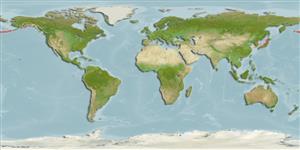Environment: milieu / climate zone / depth range / distribution range
Ecología
marino demersal; rango de profundidad 74 - 220 m (Ref. 50610). Temperate
North Pacific: off Abashiri, Japan, off Paramushir Island in the Kuril Islands and the shore of Igitkin Island in the Aleutian chain.
Tamaño / Peso / Age
Maturity: Lm ? range ? - ? cm
Max length : 6.5 cm SL macho / no sexado; (Ref. )
Short description
Morfología | Morfometría
Espinas dorsales (total): 7; Radios blandos dorsales (total): 9-11; Espinas anales 0; Radios blandos anales: 10. Body with bony tubercles and dermal papillae; no bony tubercles on interorbital region; first dorsal fin high, crescent in shape; nostril and sensory pores on lower jaw with long tubes (Ref. 559).
Life cycle and mating behavior
Madurez | Reproducción | Puesta | Huevos | Fecundidad | Larva
Masuda, H., K. Amaoka, C. Araga, T. Uyeno and T. Yoshino, 1984. The fishes of the Japanese Archipelago. Vol. 1. Tokai University Press, Tokyo, Japan. 437 p. (text). (Ref. 559)
IUCN Red List Status (Ref. 130435)
Threat to humans
Harmless
Human uses
Más información
Nombres comunesSinónimosMetabolismoDespredadoresEcotoxicologíaReproducciónMadurezPuestaAgregación para la puestaFecundidadHuevosEgg development
Age/SizeCrecimientoLength-weightLength-lengthLength-frequenciesMorfometríaMorfologíaLarvaDinámica larvariaReclutamientoAbundanciaBRUVS
ReferenciasAcuiculturaPerfil de acuiculturaRazasGenéticaElectrophoresesheritabilidadEnfermedadesProcesamientoNutrientsMass conversion
ColaboradoresImágenesStamps, Coins Misc.SonidosCiguateraVelocidadTipo de nataciónSuperficie branquialOtolitosCerebrosVisión
Herramientas
Special reports
Download XML
Fuentes de Internet
Estimates based on models
Preferred temperature (Ref.
123201): 2.5 - 11.6, mean 4.7 °C (based on 46 cells).
Phylogenetic diversity index (Ref.
82804): PD
50 = 0.5000 [Uniqueness, from 0.5 = low to 2.0 = high].
Bayesian length-weight: a=0.02089 (0.00774 - 0.05639), b=3.03 (2.79 - 3.27), in cm total length, based on LWR estimates for this (Sub)family-body shape (Ref.
93245).
Nivel trófico (Ref.
69278): 3.2 ±0.4 se; based on size and trophs of closest relatives
Resiliencia (Ref.
120179): Alto, población duplicada en un tiempo mínimo inferior a 15 meses (Preliminary K or Fecundity.).
Fishing Vulnerability (Ref.
59153): Low vulnerability (10 of 100).
